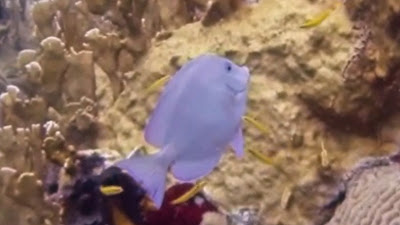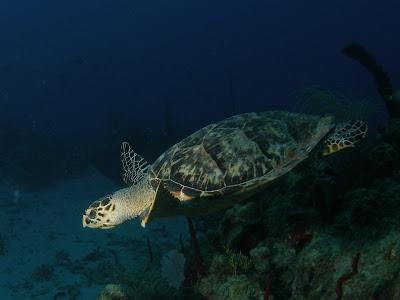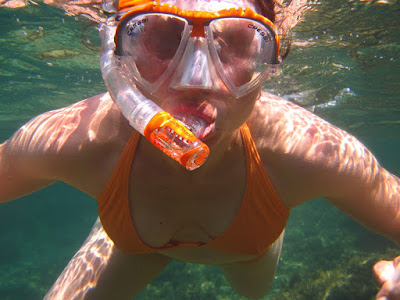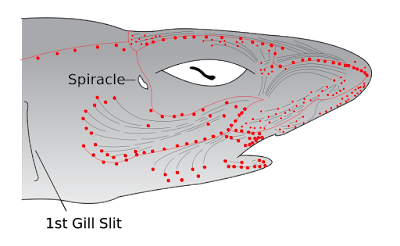WARNING! GRAPHIC IMAGES
Sharks are one of my favorite animals. They are beautiful, graceful, intelligent, and powerful. They are an important apex predator and they keep the ocean in balance and healthy. I love seeing sharks in the wild. My latest encounter with a shark while on a dive was a shocking one, and I will never forget it.
We were diving Cow Rock, probably the most famous dive site near St. Thomas in the US Virgin Islands. It is located inside of a marine sanctuary, so the reef is especially healthy. Cow Rock is a dive site with abundant marine life, colorful corals and sponges, numerous swim-throughs. It is not uncommon to see a reef shark or a nurse shark on a dive at Cow.
This time we saw a Caribbean Reef Shark. These sharks are usually seen swimming along the reef, but this one was on the bottom. They are usually very shy, but this shark didn't move at all. As we approached to get a closer look, we saw that the back section of it's body was missing! It was clearly dead. This broke my heart, but also made me want to investigate to understand how this could have happened. I decided to spend my entire 45 minute dive investigating and taking photos to try to solve this mystery.
 |
| Image by Amy Kelley |
 |
| Image by Amy Kelley |
The shark was severed completely, and everything behind the pelvic fin was gone. Had it been intact, I think it would have been between 4 and 5 feet in length. Sharks do not have any bone, just cartilage. Would that have made it easier to tear apart? It seemed like it had been there a day or two, since there was some slimy algae growth beginning on its skin, and the flesh was starting to break down.
 |
| Image by Amy Kelley |
 |
| Image by Amy Kelley |
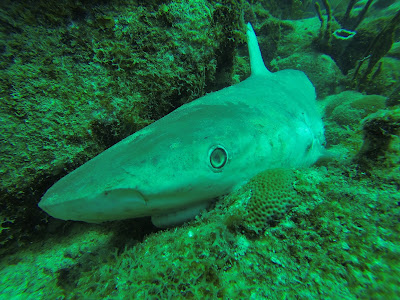 |
| Image by Amy Kelley |
I'm pretty sure it was a female, since I did not see any claspers near her pevic fins. Claspers are used by mating males to transfer sperm to the female. Male sharks and rays have a set of claspers at the back of their pelvic fin while females do not.
 |
| Image by Amy Kelley |
There were distinct bite marks, especially on the left side of the shark. It had to have been a sizable creature, based on the bite marks. If you look closely, you can see a less dramatic mark of where the top teeth of the predator dug into its prey on the top of this shark's back. Sharks can unhinge their jaws, so their bite mark can be very big and almost circular.
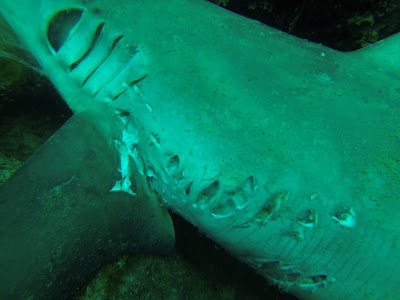 |
| Image by Amy Kelley |
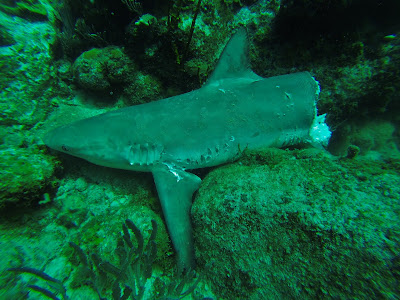 |
| Image by Amy Kelley |
 |
| Image by Amy Kelley |
I searched for teeth from the predator, since they often lose teeth when eating. Sharks have multiple rows of teeth, and when they lose one, a tooth from the next row will move forward to take its place. If I could find a tooth, maybe it could help me to identify the shark or estimate the size of the shark that left these marks. Unfortunately, I did not find any lost teeth.
On her right side there were some more bite marks and some scratches. I'm not sure that these were inflicted by the same predator.
 |
| Image by Amy Kelley |
 |
| Image by Amy Kelley |
I was a surprised not to see too many creatures taking advantage of a dead shark on the reef. It seems like it would be an easy meal. I did see lots of fire worms and a brittle star. And after I stirred things up a little bit with my investigation, some damselfish, yellowtail snapper, and a coney came by to check it out. My husband was standing watch, and he later told me that he saw two other sharks in the distance, but they were not comfortable approaching with us there. The sound of our bubbles often deters sharks too.
 |
| Image by Amy Kelley |
I was still unsure what had happened to this beautiful creature.
It was a shame that this shark's life had ended prematurely, but I decided that I would not let it be in vain. I wanted to figure out what happened to her, learn something new from this encounter, and educate others.
Getting to look into her prehistoric eyes, her complex gills, her powerful mouth and getting close enough to see her ampullae of Lorenzini was an amazing experience on a scientific level.
It is a common myth that sharks have poor vision. This is quite untrue. Their vision in the water is up to ten times better than humans' vision. Looking into these amazing eyes inspired me to do some research and learn more. You can read more about shark eyesight by reading this article by Shark Savers.
 |
| Image by Amy Kelley |
This shark we found had 5 gills on each side. Reef sharks are Requiem sharks, a type of shark that needs to move water through its mouth and over its gills to breathe. Oxygen is absorbed into the shark's blood vessels and delivered throughout his/her body. That is why you normally see reef sharks swimming along the reef and not resting on the bottom. You can learn more about sharks' gills and their anatomy by reading this article by Shark Trust.
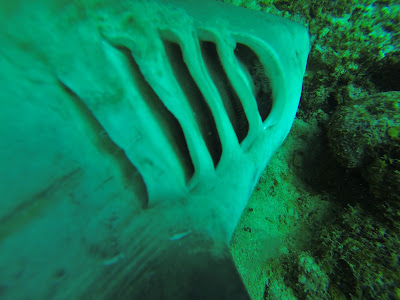 |
| Image by Amy Kelley |
Ampullae of Lorenzini may just look like tiny pores on a shark's skin, but they are so much more interesting than that. They are an interconnected system of jelly-filled sensory organs that help sharks detect electrical fields in the water. The ampullae of Lorenzini enable sharks to find prey by sensing their muscle contractions, to sense temperature changes, and to navigate their way through the water by sensing Earth's magnetic field!
 |
| Image by Amy Kelley |
I hope this is the last time I see a dead shark. It was both fascinating but heartbreaking at the same time. Though the mystery has not been completely solved, my guess is that she was killed by another shark. Either she was injured or ill, or in a dispute over territory.
Other theories that I heard people say were:
She was hit and killed by a boat propeller - I don't think this is true, since reef sharks are not surface feeders. They mostly eat fish, rays, and cephalopods (squid & octopus). Also, the nature of her wounds did not look like a propeller to me. Finally, she was found in a place that would make it highly unlikely to find boats because the dive site Cow Rock is a definite navigational hazard and the boat would be at extremely high risk of going aground.
Fishermen killed her - I don't think this is true either. First of all, this is inside of a Marine Sanctuary (though that doesn't necessarily stop some people). Secondly, the fins were still on the shark and the meatiest, most valuable part of the shark was not taken.
In trying to figure out possible causes of death I came across some extremely interesting videos, which raised new questions:
Shark mating on the Discovery Channel - A male shark bites down on a female's pectoral fin to pin her down so he can mate with her. Was our shark the victim of a mating attempt gone wrong? Interesting possibility, but I don't think so because the bite marks weren't right over her pectoral fin. Plus, eating half of the female would not be a productive way to make baby sharks!
The aquarium official think that this was a turf war. The female shark was tired of being bumped into by the male shark. He was in her space. Watching this video really helped me to understand that this clearly is possible. There are known to be a couple of reef sharks at Cow Rock, and maybe this female was in another shark's zone. But her tail was bitten off, unlike in the video where the whole shark was eaten, head first.
This made me realize that there are, indeed, apex predators even above the shark. Bigger sharks and killer whales are definitely capable of killing a shark. Not to mention humans, the most vicious apex predator of all. This doesn't mean that I think an Orca killed this shark, but it does prove to me that there are apex predators capable of taking down a 5 foot reef shark. I found one image that really makes me think another shark could have done this to her.
Although I am pretty sure her death was all natural and unrelated to humans, please keep in mind that shark populations are incredibly important to our planet. Without sharks, the apex predator of the ocean, Earth's largest ecosystem would not be able to stay healthy. Without a healthy ocean, our planet cannot survive. Read more about why sharks are important at Sharkallies.com. According to this article by IFLScience, humans are responsible for killing between 100 million and 273 million sharks per year.
Their populations have decreased drastically, and we need to do all we can to save them. For starters, do not support restaurants that serve shark. Sadly, there are a few here in the Virgin Islands. Next, do not support fishing operations that hunt sharks. Finally, get involved in ocean conservation efforts. Even something as simple as signing a petition to save sharks can make a difference.
Here is a video clip of our strange shark encounter.
Video by Amy Kelley
I would love to hear your comments. I am very eager to solve this mystery, so please share this blog with any shark experts you may know!





